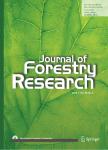Monitoring spatiotemporal soil moisture changes in the subsurface of forest sites using electrical resistivity tomography (ERT)
Monitoring spatiotemporal soil moisture changes in the subsurface of forest sites using electrical resistivity tomography(ERT)作者机构:Institute of Geography and GeologyUniversity of WürzburgAm Hubland97074 WürzburgGermany
出 版 物:《Journal of Forestry Research》 (林业研究(英文版))
年 卷 期:2022年第33卷第5期
页 面:1649-1662页
核心收录:
学科分类:09[农学] 0903[农学-农业资源与环境] 090301[农学-土壤学]
基 金:This scientific study could be realized with the help of two start-up funds (the so-called research fund of the University of Würzburg and a university sponsorship award of the Mainfränkische Wirtschaft),both of which were applied for and awarded to C.Kneisel Based on these preliminary investigations,a longer-term third-party funded project could be realized (2218WK22X1)
主 题:Geoelectrical monitoring Forest ecology Hydrology Soil water content
摘 要:The effects of drought on tree mortality at forest stands are not completely understood. For assessing their water supply, knowledge of the small-scale distribution of soil moisture as well as its temporal changes is a key issue in an era of climate change. However, traditional methods like taking soil samples or installing data loggers solely collect parameters of a single point or of a small soil volume. Electrical resistivity tomography (ERT) is a suitable method for monitoring soil moisture changes and has rarely been used in forests. This method was applied at two forest sites in Bavaria, Germany to obtain high-resolution data of temporal soil moisture variations. Geoelectrical measurements (2D and 3D) were conducted at both sites over several years (2015-2018/2020) and compared with soil moisture data (matric potential or volumetric water content) for the monitoring plots. The greatest variations in resistivity values that highly correlate with soil moisture data were found in the main rooting zone. Using the ERT data, temporal trends could be tracked in several dimensions, such as the interannual increase in the depth of influence from drought events and their duration, as well as rising resistivity values going along with decreasing soil moisture. The results reveal that resistivity changes are a good proxy for seasonal and interannual soil moisture variations. Therefore, 2D- and 3D-ERT are recommended as comparatively non-laborious methods for small-spatial scale monitoring of soil moisture changes in the main rooting zone and the underlying subsurface of forested sites. Higher spatial and temporal resolution allows a better understanding of the water supply for trees, especially in times of drought.



